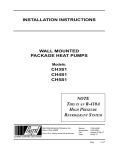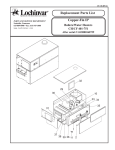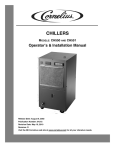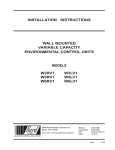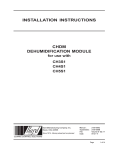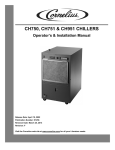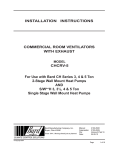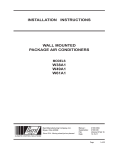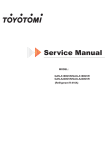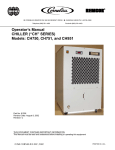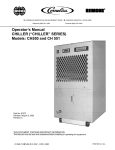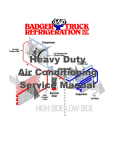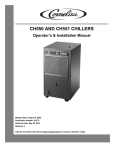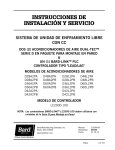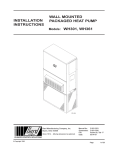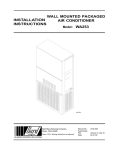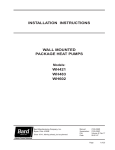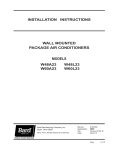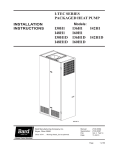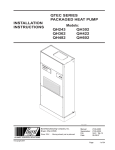Download Barco R9010510 Projector User Manual
Transcript
INSTALLATION INSTRUCTIONS WALL MOUNTED PACKAGE HEAT PUMPS Models: CH3S1 CH4S1 CH5S1 NOTE THIS IS AN R-410A HIGH PRESSURE REFRIGERANT SYSTEM Bard Manufacturing Company, Inc. Bryan, Ohio 43506 Since 1914...Moving ahead just as planned. © Copyright 2004 Manual : Supersedes: File: Date: 2100-455A 2100-455 Volume III Tab 17 08-18-06 Manual Page 2100-455A 1 of 25 CONTENTS Getting Other Information and Publications For More Information ............................................... 3 Wall Mount General Heat Pump Wall Mount Model Nomenclature ....... 4 Shipping Damage ................................................. 8 General .............................................................. 8 Duct Work ............................................................. 8 Filters .............................................................. 8 Condensate Drain – Evaporator ........................... 8 Installation Instructions Wall Mounting Information .................................... 9 Mounting the Unit .................................................. 9 Wiring – Main Power ........................................... 15 Wiring – Low Voltage Wiring ............................... 15 Low Voltage Connections ................................... 16 Figures Figure 1 Figure 2 Figure 3 Figure 4 Figure 5 Figure 6 Figure 7 Figure 8 Figure 9 Figure 10 Figure 11 Figure 12 Figure 13 Unit Dimensions CH3S1 ...................... 5 Unit Dimensions CH4S1 & CH5S1 ...... 6 Mounting Instructions CH3S1 ............ 10 Mounting Instructions CH4S1/CH5S1 . 11 Electric Heat Clearance ..................... 12 Wall Mounting Instructions ................. 13 Wall Mounting Instructions ................. 13 Common Wall Mounting Installations . 14 Common Wall Mounting Installations . 15 Unit 24V Terminal Board .................... 15 Low Pressure Control Bypass Timer . 17 Defrost Control Board ........................ 19 Fan Blade Setting .............................. 22 Manual 2100-455A Page 2 of 25 Start Up Application .......................................................... 16 Safety Practices .................................................. 17 Important Installer Note ....................................... 17 Pressure Service Ports ....................................... 17 High & Low Pressure Switch .............................. 17 Three Phase Scroll Compressor Start Up ... 17 & 18 Phase Monitor ..................................................... 18 Service Hints ....................................................... 18 Sequence of Operation ....................................... 18 Compressor Current & Pressure Control Module ................................................... 18 Defrost Cycle ...................................................... 19 Troubleshooting Solid State Heat Pump Control Troubleshooting Procedure ................................. 20 Checking Temperature Sensor Outside Unit Circuit ............................................. 21 Temperature vs. Resistance of Temperature ...... 21 Compressor Solenoid ......................................... 22 Fan Blade Setting Dimensions ........................... 22 Removal of Fan Shroud ...................................... 22 Refrigerant Charge R-410A ................................ 22 Pressure Tables ............................................. 24-25 Tables Table 1 Table 2 Table 3 Table 4 Table 5 Table 6 Table 7 Table 8 Table 9 Table 10 Table 11 Table 12 Table 13 Electric Heat Table ................................ 4 Electrical Specifications ........................ 7 Thermostat Wire Size ......................... 15 Wall Thermostat .................................. 16 Troubleshooting .................................. 20 Fan Blade Dimensions ........................ 22 Refrigerant Charge ............................. 23 Indoor Blower Performance ................ 23 Maximum ESP of Operation ............... 23 Pressure Table - High Cooling ............ 24 Pressure Table - Low Cooling ............. 24 Pressure Table - High Heating ............ 25 Pressure Table - Low Heating ............. 25 Getting Other Information and Publications These publications can help you install the air conditioner or heat pump. You can usually find these at your local library or purchase them directly from the publisher. Be sure to consult current edition of each standard. FOR MORE INFORMATION, CONTACT THESE PUBLISHERS: ACCA Air Conditioning Contractors of America 1712 New Hampshire Ave. N.W. Washington, DC 20009 Telephone: (202) 483-9370 Fax: (202) 234-4721 ANSI American National Standards Institute 11 West Street, 13th Floor New York, NY 10036 Telephone: (212) 642-4900 Fax: (212) 302-1286 National Electrical Code ...................... ANSI/NFPA 70 Standard for the Installation .............. ANSI/NFPA 90A of Air Conditioning and Ventilating Systems Standard for Warm Air ...................... ANSI/NFPA 90B Heating and Air Conditioning Systems Load Calculation for ............................ ACCA Manual J Residential Winter and Summer Air Conditioning Duct Design for Residential .............. ACCA Manual D Winter and Summer Air Conditioning and Equipment Selection ASHRAE American Society of Heating, Refrigerating, and Air Conditioning Engineers, Inc. 1791 Tullie Circle, N.E. Atlanta, GA 30329-2305 Telephone: (404) 636-8400 Fax: (404) 321-5478 NFPA National Fire Protection Association Batterymarch Park P.O. Box 9101 Quincy, MA 02269-9901 Telephone: (800) 344-3555 Fax: (617) 984-7057 Manual 2100-455A Page 3 of 25 WALL MOUNT GENERAL INFORMATION HEAT PUMP WALL MOUNT MODEL NOMENCLATURE CH 4S 1 – A 05 B P X X X X MODEL NUMBER CONTROL MODULES KW COIL OPTIONS X - Standard CAPACITY REVISIONS 3S - 3 ton 4S - 4 ton 5S - 5 ton VOLTS & PHASE A - 230/208/60/1 B - 230/208/60/3 C - 460/60/3 OUTLET OPTIONS X - Front (Standard) T - Top Outlet VENTILATION OPTIONS B - Blank-off Plate R - Energy Recovery V - Commercial Ventilator Motorized with Exhaust COLOR OPTIONS X - Beige (Standard) 4 - Buckeye Gray 5 - Desert Brown 8 - Dark Bronze FILTER OPTIONS P - 2-Inch Pleated TABLE 1 ELECTRIC HEAT TABLE CH3S1-A Models 240-1 KW A B TU CH3S1-B 208-1 A B TU 240-3 A B TU 208-3 A B TU 460-3 A B TU 4 5 CH4S1-A CH5S1-A CH3S1-C 240-1 A B TU CH4S1-B CH5S1-B 208-1 A B TU 240-3 A B TU CH4S1-C CH5S1-C 208-3 A B TU 460-3 A B TU 7.2 20480 16.7 13650 14.4 10240 20.8 17065 18.1 12800 20.8 17065 18.1 12800 6 14.4 20500 12.5 15360 9 21.7 30600 18.7 23030 10.8 30700 7.2 20480 14.4 20500 12.5 15360 21.7 30600 18.7 23030 10.8 30700 10 41.6 34130 36.2 25600 15 62.5 51200 54.1 38400 36.2 51200 31.2 38400 18.0 51200 62.5 51200 54.1 38400 36.2 51200 31.2 38400 18.0 51200 41.6 34130 36.2 25600 18 20 Manual 2100-455A Page 4 of 25 43.3 61400 37.5 46050 21.6 61400 83.2 68250 72.1 51200 Manual 2100-455A Page 5 of 25 Left Side View Cond. Outlet Grille Slope Top Evap. Drain Hose Vent Option Access Door Filter Access Door Blower Access Door 1 3/8" Heater Access Door 31 5/8" 13 3/8" High Voltage Entrance Low Voltage Entrance C. Breaker Access Door Control Panel Door 84 11/16" 6 7/8" 5 13/16" Drain for optional drain pan Front View Cond. Inlet Grille 42 3/16" 43 7/8" Top View Optional Top Outlet 39 7/8" 31"" 16" Access Door 32 3/4" 16" 16" 16" 16" 7/8" 6 9/16" Back View Return Opening Supply Opening 29 7/8" 43" "CH3S1" Unit Dimensions Right Side View Cond. Outlet Grille FIGURE 1 UNIT DIMENSIONS MIS-2146 Opt. High Voltage Entrances (12) Wall Mounting Holes 8 9/16" 2 1/4" 48 1/16" Top Rain Flashing 15 7/8" 6 1/8" 9 13/16" Manual 2100-455A Page 6 of 25 Left Side View Cond. Outlet Grille Slope Top Evap. Drain Hose Vent Option Access Door Filter Access Door Blower Access Door 1 3/8" Front View Heater Access Door 41 5/8" 13 3/8" Access Door High Voltage Entrance Low Voltage Entrance C. Breaker Access Door Control Panel Door 94 11/16" 6 7/8" 5 13/16" Drain for optional drain pan Condenser Inlet Grille 43 7/8" 42 3/16" Top View Optional Top Outlet 39 7/8" Right Side View 22 3/16" Cond. Outlet Grille 31" (12) Wall Mounting Holes 42 3/4" 16" 16" 16" 16" 16" 7/8" 6 9/16" Back View Return Opening Supply Opening 29 7/8" 43" MIS-2020 A Opt. High Voltage Entrances 2 1/4" 48 1/16" Top Rain Flashing 15 7/8" 6 1/8" 9 13/16" 8 9/16" "CH4S1 and CH5S1" Unit Dimensions FIGURE 2 UNIT DIMENSIONS TABLE 2 ELECTRICAL SPECIFICATIONS SINGLE CIRCUIT DUAL CIRCUIT 1 N o. 3 1 2 2 3 2 2 Maximum Field Minimum Maximum Field Ground Minimum Circuit Field Pow er Ground External Fuse Pow er Circuit External Pow er Wire Ampacity Wire Siz e Wire Siz e or Circuit Ciruits Ampacity Fuse or Wire Siz e Breaker Circuit Siz e Breaker Ckt. Ckt. Ckt. Ckt. Ckt. Ckt. Ckt. Ckt. Ckt. Ckt. Ckt. Ckt. A B C A B C A B C A B C Model Rated Volts & P h ase CH3S1-A0Z A 05 A 10 A 15 230/208-1 230/208-1 230/208-1 230/208-1 1 1 1 or 2 1 or 2 29 55 81 85 45 60 90 90 8 6 4 4 10 10 8 8 ----29 33 ----52 52 --------- ----45 45 ----60 60 --------- ----10 8 ----6 6 --------- ----10 10 ----10 10 --------- CH3S1-B0Z B 06 B 09 B 15 230/208-3 230/208-3 230/208-3 230/208-3 1 1 1 1 23 41 50 50 30 45 50 50 10 8 8 8 10 10 10 10 --------- --------- --------- --------- --------- --------- --------- --------- --------- --------- --------- --------- CH3S1-C0Z C 06 C 09 C 15 460-3 460-3 460-3 460-3 1 1 1 1 11 20 24 24 15 20 25 25 14 12 10 10 14 12 10 10 --------- --------- --------- --------- --------- --------- --------- --------- --------- --------- --------- --------- CH4S1-A0Z A 04 A 05 A 10 A 15 A 20 230/208-1 230/208-1 230/208-1 230/208-1 230/208-1 230/208-1 1 1 1 or 2 1 or 2 1 or 2 1 or 3 37 57 63 89 89 113 50 60 70 90 90 120 8 6 6 3 3 2 10 10 8 8 8 6 ----37 37 37 52 ----26 52 52 52 ----------26 ----50 50 50 50 ----30 60 60 60 ----------30 ----8 8 8 6 ----10 6 6 6 ----------10 ----10 10 10 10 ----10 10 10 10 ----------10 CH4S1-B0Z B 06 B 09 B 15 B 18 230/208-3 230/208-3 230/208-3 230/208-3 230/208-3 1 1 1 1 1 27 45 54 54 55 35 50 60 60 60 8 8 6 6 6 10 10 10 10 10 ----------- ----------- ----------- ----------- ----------- ----------- ----------- ----------- ----------- ----------- ----------- ----------- CH4S1-C0Z C 06 C 09 C 15 C 18 460-3 460-3 460-3 460-3 460-3 1 1 1 1 1 14 23 28 28 28 20 25 30 30 30 12 10 10 10 10 12 10 10 10 10 ----------- ----------- ----------- ----------- ----------- ----------- ----------- ----------- ----------- ----------- ----------- ----------- CH5S1-A0Z A 04 A 05 A 10 A 15 A 20 230/208-1 230/208-1 230/208-1 230/208-1 230/208-1 230/208-1 1 1 or 2 1 or 2 1 or 2 1 or 2 1 or 3 44 65 70 96 96 114 60 70 80 100 100 120 6 4 4 3 3 2 10 8 8 8 8 6 --44 44 44 44 44 --21 26 52 52 52 ----------26 --60 60 60 60 60 --25 30 60 60 60 ----------30 --8 8 8 8 8 --10 10 6 6 6 ----------10 --10 10 10 10 10 --10 10 10 10 10 ----------10 CH5S1-B0Z B 06 B 09 B 15 B 18 230/208-3 230/208-3 230/208-3 230/208-3 230/208-3 1 1 2 2 2 36 54 63 63 64 50 60 70 70 70 8 6 4 4 4 10 10 6 6 6 ----36 36 37 ----28 28 28 ----------- ----50 50 50 ----30 30 30 ----------- ----8 8 8 ----10 10 10 ----------- ----10 10 10 ----10 10 10 ----------- CH5S1-C0Z C 06 C 09 C 15 C 18 460-3 460-3 460-3 460-3 460-3 1 1 1 1 1 19 28 32 32 33 25 35 35 35 35 10 8 8 8 8 10 10 10 10 10 ----------- ----------- ----------- ----------- ----------- ----------- ----------- ----------- ----------- ----------- ----------- ----------- 1 Maximum size of the time delay fuse or HACR type circuit breaker for protection of field wiring conductors. 2 Based on 75°C copper wire. All wiring must conform to NEC and all local codes. 3 These “Minimum Circuit Ampacity” values are to be used for sizing the field power conductors. Refer to the National Electric Code (latest revision), Article 310 for power conductor sizing. CAUTION: When more than one field power conductor circuit is run through one conduit, the conductors must be derated. Pay special attention to note 8 of table 310 regarding Ampacity Adjustment Factors when more than 3 conductors are in a raceway. Manual 2100-455A Page 7 of 25 SHIPPING DAMAGE Upon receipt of equipment, the carton should be checked for external signs of shipping damage. If damage is found, the receiving party must contact the last carrier immediately, preferably in writing, requesting inspection by the carrier’s agent. GENERAL The equipment covered in this manual is to be installed by trained, experienced service and installation technicians. Design the duct work according to methods given by the Air Conditioning Contractors of America (ACCA). When duct runs through unheated spaces, it should be insulated with a minimum of one inch of insulation. Use insulation with a vapor barrier on the outside of the insulation. Flexible joints should be used to connect the duct work to the equipment in order to keep the noise transmission to a minimum. These units are suitable for 0 inch clearance to combustible material. See Wall Mounting Instructions and Figures 3, 4, 5, 6 & 7 for further details. The refrigerant system is completely assembled and charged. All internal wiring is complete. Ducts through the walls must be insulated and all joints taped or sealed to prevent air or moisture entering the wall cavity. The unit is designed for use with or without duct work. Flanges are provided for attaching the supply and return ducts. Some installations may not require any return air duct. A metallic return air grille is required with installations not requiring a return air duct. The spacing between louvers on the grille shall not be larger than 5/8 inch. These instructions explain the recommended method to install the air cooled self-contained unit and the electrical wiring connections to the unit. NOTE: If no return air duct is used, applicable installation codes may limit this cabinet to installation only in a single story structure. These instructions and any instructions packaged with any separate equipment, required to make up the entire air conditioning system should be carefully read before beginning the installation. Note particularly “Starting Procedure” and any tags and/or labels attached to the equipment. Any grille that meets with 5/8 inch louver criteria may be used. It is recommended that Bard Return Air Grille Kit RG2 through RG5 or RFG2 through RFG5 be installed when no return duct is used. Contact distributor or factory for ordering information. If using a return air filter grille, filters must be of sufficient size to allow a maximum velocity of 400 fpm. While these instructions are intended as a general recommended guide, they do not supersede any national and/or local codes in any way. Authorities having jurisdiction should be consulted before the installation is made. See Page 3 for information on codes and standards. Size of unit for a proposed installation should be based on heat loss calculation made according to methods of Air Conditioning Contractors of America (ACCA). The air duct should be installed in accordance with the Standards of the National Fire Protection Association for the Installation of Air Conditioning and Ventilating Systems of Other Than Residence Type, NFPA No. 90A, and Residence Type Warm Air Heating and Air Conditioning Systems, NFPA No. 90B. Where local regulations are at a variance with instructions, installer should adhere to local codes. DUCT WORK Any heat pump is more critical of proper operating charge and an adequate duct system than a straight air conditioning unit. All duct work, supply and return, must be properly sized for the design airflow requirement of the equipment. Air Conditioning Contractors of America (ACCA) is an excellent guide to proper sizing. All duct work or portions thereof not in the conditioned space should be properly insulated in order to both conserve energy and prevent condensation or moisture damage. Manual 2100-455A Page 8 of 25 FILTERS A 2-inch pleated filter is supplied with each unit. The filter slides into position making it easy to service. This filter can be serviced from the outside by removing the filter access door. CONDENSATE DRAIN – EVAPORATOR A plastic drain hose extends from the drain pan at the top of the unit down to the unit base. There are openings in the unit base for the drain hose to pass through. In the event the drain hose is connected to a drain system of some type, it must be an open or vented type system to assure proper drainage. INSTALLATION INSTRUCTIONS WALL MOUNTING INFORMATION 1. Two holes for the supply and return air openings must be cut through the wall as shown in Figure 3. 3. Locate and mark lag bolt locations and bottom mounting bracket location. See Figure 3. 4. Mount bottom mounting bracket. 2. On wood frame walls, the wall construction must be strong and rigid enough to carry the weight of the unit without transmitting any unit vibration. 5. Hook top rain flashing under back bend of top. Top rain flashing is shipped with unit attached to back of unit on the right side. 3. Concrete block walls must be thoroughly inspected to insure that they are capable of carrying the weight of the installed unit. 6. Position unit in opening and secure with 5/16 lag bolts; use 3/4 inch diameter flat washers on the lag bolts. MOUNTING THE UNIT 1. These units are secured by wall mounting brackets which secure the unit to the outside wall surface at both sides. A bottom mounting bracket is provided for ease of installation, but is not required. 2. The unit itself is suitable for 0 inch clearance. If a combustible wall use a minimum of 30" x 10" dimensions for sizing. However, it is generally recommended that a 1-inch clearance is used for ease of installation. The supply air opening would then be 32" x 12". See Figures 3 and 4 for details. 7. Secure rain flashing to wall and caulk across entire length of top. See Figure 3. 8. For additional mounting rigidity, the return air and supply air frames or collars can be drilled and screwed or welded to the structural wall itself (depending upon wall construction). Be sure to observe required clearance if combustible wall. 9. On side-by-side installations, maintain a minimum of 20 inches clearance on right side to allow access to control panel and heat strips, and to allow proper airflow to the outdoor coil. Additional clearance may be required to meet local or national codes. Manual 2100-455A Page 9 of 25 18" 3 D 12 32 5 16" 16" 16" 16" 16" 68" C 5 1/2 6 1/2 C 16" 30" Return Opening Supply Opening A 43" 10 30 B 16" 16" 16" 16" C REQUIRED DIM. TO MAINTAIN 0" MIN. CLEARANCE FROM COMBUSTIBLE MATERIALS REQUIRED DIM. TO MAINTAIN OPTIONAL 1" CLEARANCE FROM COMBUSTIBLE MATERIALS A "CH3S1" Wall Mounting Instructions 2 1 D 5 6 E 16" E B Heater Access Panel Wall Bottom Wall Bracket (Install before unit) Unit Mounting Holes, 12 places D FIGURE 3 MOUNTING INSTRUCTIONS Optional Top Outlet 68" 7 Top Apply a bead of caulk along entire length of top and behind side mounting flanges Rain Flashing (supplied) 3 18" Return Air Opening Supply Duct Wall Section Manual 2100-455A Page 10 of 25 MIS-2209 0" min. 0" min. Foam Manual 2100-455A Page 11 of 25 ' & 5HWXUQ2SHQLQJ 6XSSO\2SHQLQJ $ & ( % %RWWRP:DOO%UDFNHW ,QVWDOOEHIRUHXQLW :DOO 5DLQ)ODVKLQJVXSSOLHG 2SWLRQDO 7RS2XWOHW 7RS $SSO\DEHDGRIFDXON DORQJHQWLUHOHQJWKRIWRS DQGEHKLQGVLGHPRXQWLQJ IODQJHV +HDWHU $FFHVV 3DQHO 8QLW0RXQWLQJ +ROHVSODFHV ' &+6DQG&+6:DOO0RXQWLQJ,QVWUXFWLRQV FIGURE 4 MOUNTING INSTRUCTIONS 5HWXUQ$LU 2SHQLQJ )RDP PLQ 0,6$ PLQ 6XSSO\'XFW :DOO6HFWLRQ FIGURE 5 ELECTRIC HEAT CLEARANCE Typical Building Outside Sheeting Wall Frame Inside Sheeting Supply Air Duct Unit Supply Air Duct Flange of Wall 1" OPTIONAL CLEARANCE RECOMMENDED Side section view of supply air duct for wall mounted unit showing 0" clearance to combustible surfaces. MIS-2210 Note: This unit is approved for 0" clearance, but the optional 1" clearance is recommended. See Figures 3 & 4. Manual 2100-455A Page 12 of 25 FIGURE 6 WALL MOUNTING INSTRUCTIONS Interior finished wall Exterior wood or steel siding wall Supply opening Framing material: 2x4's, 2x6's, and/or structural steel Factory supplied rain flashing. Attach to unit before installing. Return opening "CH" Unit Bottom mounting bracket. Mount on wall before installing unit. ! Follow all local building codes when framing wall to support unit. MIS-2024 FIGURE 7 WALL MOUNTING INSTRUCTIONS 44 7/8" 29 7/8" Supply Opening 9 13/16" 1" clearance 6 1/8" Return Opening 15 7/8" 1" clearance Locate stud to match spacing for rest of wall. A second member may be required for some walls. 51 1/4" These structural members must be able to support the entire weight of the unit. CL ! Follow all local building codes when framing wall to support unit. MIS-2025 Manual 2100-455A Page 13 of 25 FIGURE 8 COMMON WALL MOUNTING INSTALLATIONS Free Air Flow - No Duct Low Sound With Acoustical Plenums And Isolation Curbs Free Air Flow - No Duct Unit (outside) Rafters Finished Ceiling Grille Isolation Curb WM1CF5-X ir yA ppl u S Supply Air Free Blow Supply Plenum WAFB51-X Return Air Grille Outside Wall Return Air Silencer WAPR11-X RETURN AIR Ducted Supply - Return At Unit False Wall Installation Note: duct maybe in attic or below rafters as shown. Rafters Unit (outside) Supply Air Note: duct maybe in attic or below rafters as shown. Rafters Unit (outside) Supply Air Duct Finished Ceiling Finished Ceiling Wall Sleeve Return Air False Wall Outside Wall Note: direction of return grille louvers is pointed down for lowest sound level as shown. Return Air Outside Wall Duct Return Air Grille MIS-2027 Manual 2100-455A Page 14 of 25 FIGURE 9 COMMON WALL MOUNTING INSTALLATIONS Closet Installation Note: duct maybe in attic or below rafters as shown. Rafters Unit (outside) WIRING – LOW VOLTAGE WIRING 230 / 208V, 1 phase and 3 phase equipment dual primary voltage transformers. All equipment leaves the factory wired on 240V tap. For 208V operation, reconnect from 240V to 208V tap. The acceptable operating voltage range for the 240 and 208V taps are: Duct Supply Air Finished Ceiling TAP 240 208 Grille Wall Sleeve RANGE 253 – 216 220 – 187 Closet Wall Closet Wall Return Air Outside Wall NOTE: The voltage should be measured at the field power connection point in the unit and while the unit is operating at full load (maximum amperage operating condition). Raised Closet Floor FIGURE 10 UNIT 24V TERMINAL BOARD Grille Return Air T7652H1000 THERMOSTAT BARD PART #8403-052 MIS-2240 WIRING – MAIN POWER Refer to the unit rating plate for wire sizing information and maximum fuse or “HACR” type circuit breaker size. Each outdoor unit is marked with a “Minimum Circuit Ampacity”. This means that the field wiring used must be sized to carry that amount of current. Depending on the installed KW of electric heat, there may be two field power circuits required. If this is the case, the unit serial plate will so indicate. All models are suitable only for connection with copper wire. Each unit and/or wiring diagram will be marked “Use Copper Conductors Only”. These instructions must be adhered to. Refer to the National Electrical Code (NEC) for complete current carrying capacity data on the various insulation grades of wiring material. All wiring must conform to NEC and all local codes. The electrical data lists fuse and wire sizes (75° C copper) for all models including the most commonly used heater sizes. Also shown are the number of field power circuits required for the various models with heaters. The unit rating plate lists a “Maximum Time Delay Relay Fuse” or “HACR” type circuit breaker that is to be used with the equipment. The correct size must be used for proper circuit protection and also to assure that there will be no nuisance tripping due to the momentary high starting current of the compressor motor. The disconnect access door on this unit may be locked to prevent unauthorized access to the disconnect. To convert for the locking capability, bend the tab located in the bottom left hand corner of the disconnect opening under the disconnect access panel straight out. This tab will now line up with the slot in the door. When shut, a padlock may be placed through the hole in the tab preventing entry. See “Start Up” section for important information on three phase scroll compressor start ups. C G Rc Rh Y1 Y2 B L W1 A1 1F93-380 THERMOSTAT BARD PART #8403-049 C G R Y1 Y2 B W1 W2 E C G R Y B W1 W2 W3 E Y1 W3/A1 L DH O1 UNIT LOW VOLTAGE TERMINAL BLOCK Factory Jumper MIS-2026 A Nine (9) wires should be run from thermostat subbase to the 24V terminal board in the unit. A nine conductor, 18 gauge copper color-coded thermostat cable is recommended. The connection points are shown in Figure 10. IMPORTANT Only the thermostat combinations as shown above will work with this equipment. TABLE 3 THERMOSTAT WIRE SIZE Transformer VA 55 FLA Wire Gauge Maximum Distance In Feet 2.3 20 gauge 18 gauge 16 gauge 14 guage 12 guage 45 60 100 160 250 Manual 2100-455A Page 15 of 25 LOW VOLTAGE CONNECTIONS These units use a grounded 24 volt AC low voltage circuit and require at least a 2 stage heating and a 2 stage cooling thermostat. The “R” terminal is the hot terminal and the “C” terminal is grounded. TABLE 4 WALL THERMOSTAT Thermostat Predominant Features 8403-049 (1F93-380) 2 stg. cool; 2 stg. heat Programmable Electronic Auto or Manual changeover “G” terminal is the fan input. “Y” terminal is the compressor Stage 1 input. 8403-052 “Y1” terminal is the compressor Stage 2 input. 2 stg. cool; 3 stg. heat Programmable Electronic Auto or Manual changeover “B” terminal is the reversing valve input. The reversing valve must be energized for heating mode. START UP “R” terminal is 24 VAC hot. “C” terminal is 24 VAC grounded. “L” terminal is compressor lockout output. This terminal is activated on a high or low pressure trip by the electronic heat pump control. This is a 24 VAC output. “W2” terminal is second stage heat (if equipped). “O1” terminal is the ventilation input. This terminal energizes any factory installed ventilation option. “E” terminal is the emergency heat input. This terminal energizes the emergency heat relay if equipped. NOTE: For total and proper control using DDC, a total of 7 controlled outputs are required (6 if no ventilation system is installed). For proper system operation under Emergency Heat conditions where the compressor needs to be deactivated, the B-W2-E outputs need to be energized. Removing the Y (compressor) signal alone turns the compressor off, but does not activate the additional circuitry embedded in the heat pump for proper and complete operation. LOW VOLTAGE CONNECTIONS FOR DDC CONTROL Fan Only Energize G Cooling Mode 1st Stage Energize Y, G Cooling Mode 2nd Stage Energize Y, Y1, G Heat Pump Heating 1st Stage Energize Y, G, B Heat Pump Heating 2nd Stage Energize Y, Y1, G, B 3rd Stage Heating w/Heat Pump (if employed) Energize G, W2, Y, B, Y1 Ventilation Energize G, O1 Emergency Heat Energize B, W2, E, G Manual 2100-455A Page 16 of 25 These units require R-410A refrigerant & Polyol Ester oil. APPLICATION: 1. Use separate service and manufacturing equipment to avoid cross contamination of oil and refrigerants. 2. Use recovery equipment rated for R-410A refrigerant. 3. Use manifold gauges rated for R-410A (800 psi/250 psi low). 4. R-410A is a binary blend of HFC-32 and HFC-125. 5. R-410A is nearly azeotropic - similar to R-22 and R-12. Although nearly azeotropic, charge with liquid refrigerant. 6. R-410A operates at 40-70% higher pressure than R-22, and systems designed for R-22 cannot withstand this higher pressure. 7. R-410A has an ozone depletion potential of zero, but must be reclaimed due to its global warming potential. 8. R-410A compressors use Polyol Ester oil. 9. Polyol Ester oil is hygroscopic; it will rapidly absorb moisture and strongly hold this moisture in the oil. 10. A liquid line dryer must be used - even a deep vacuum will not separate moisture from the oil. 11. Limit atmospheric exposure to 15 minutes MAXIMUM. 12. If compressor removal is necessary, always plug compressor immediately after removal. Purge with small amount of nitrogen when inserting plugs. START UP CONT’D. SAFETY PRACTICES: The bypass timer should be set to 200 seconds, and this is to assure there is no nuisance tripping of the lowpressure control during startup in heating mode under cold weather conditions. See Figure 10: 1. Never mix R-410A with other refrigerants. 2. Use gloves and safety glasses, Polyol Ester oils can be irritating to the skin, and liquid refrigerant will freeze the skin. FIGURE 11 LOW PRESSURE CONTROL BYPASS TIMER 3. Never use air and R-410A to leak check; the mixture may become flammable. 4. Do not inhale R-410A – the vapor attacks the nervous system, creating dizziness, loss of coordination and slurred speech. Cardiac irregularities, unconsciousness and ultimate death can result from breathing this concentration. 5. Do not burn R-410A. This decomposition produces hazardous vapors. Evacuate the area if exposed. 6. Use only cylinders rated DOT4BA/4BW 400. 7. Never fill cylinders over 80% of total capacity. 8. Store cylinders in a cool area, out of direct sunlight. 9. Never heat cylinders above 125°F. 10. Never trap liquid R-410A in manifold sets, gauge lines or cylinders. R-410A expands significantly at warmer temperatures. Once a cylinder or line is full of liquid, any further rise in temperature will cause it to burst. IMPORTANT INSTALLER NOTE For improved start-up performance, wash the indoor coil with a dish washing detergent. PRESSURE SERVICE PORTS R-410A requires high pressure hose connections and gauges. High and Low pressure service ports are installed on all units so that the system operating pressures can be observed. Pressure tables can be found later in the manual covering all models on both cooling and heating cycles. It is imperative to match the correct pressure table to the unit by model number. HIGH & LOW PRESSURE SWITCH All models are supplied with a remote reset high and low pressure switch. If tripped, this pressure switch may be reset by turning the thermostat off then back on again. High/Low Pressure control provides protection for the compressor. In the event system pressures go above 540 PSI or below 35 PSI, in either cooling or heating mode, the compressor will be stopped. This will activate the “L” terminal of the low voltage terminal strip. This terminal can be used for remote indication of a pressure lockout. The lockout circuit will hold compressor off line. When the system problem is corrected, the unit operation can be restored by turning the main power supply off and then back on, or reset the room thermostat. The low pressure control has a bypass to eliminate nuisance lockout on cold start up. THREE PHASE SCROLL COMPRESSOR START UP INFORMATION Scroll compressors, like several other types of compressors, will only compress in one rotational direction. Direction of rotation is not an issue with single phase compressors since they will always start and run in the proper direction. However, three phase compressors will rotate in either direction depending upon phasing of the power. Since there is a 50-50 chance of connecting power in such a way as to cause rotation in the reverse direction, verification of proper rotation must be made. All three phase units incorporate a phase monitor to ensure proper field wiring. See the “Phase Monitor” section later in this manual. Verification of proper rotation must be made any time a compressor is changed or rewired. If improper rotation is corrected at this time there will be no negative impact on the durability of the compressor. However, reverse operation for over one hour may have a negative impact on the bearing due to oil pump out. NOTE: If compressor is allowed to run in reverse rotation for several minutes, the compressor’s internal protector will trip. All three phase ZR3 compressors are wired identically internally. As a result, once the correct phasing is determined for a specific system or installation, connecting properly phased power leads to the same Fusite terminal should maintain proper rotation direction. Manual 2100-455A Page 17 of 25 Verification of proper rotation direction is made by observing that suction pressure drops and discharge pressure rises when the compressor is energized. Reverse rotation also results in an elevated sound level over that with correct rotations, as well as, substantially reduced current draw compared to tabulate values. The direction of rotation of the compressor may be changed by reversing any two line connections to the unit. PHASE MONITOR All units with three phase compressors are equipped with a 3 phase line monitor to prevent compressor damage due to phase reversal. The phase monitor in this unit is equipped with two LEDs. If the Y signal is present at the phase monitor and phases are correct, the green LED will light. If phases are reversed, the red fault LED will be lit and compressor operation is inhibited. If a fault condition occurs, reverse two of the supply leads to the unit. Do not reverse any of the unit factory wires as damage may occur. SERVICE HINTS 1. Caution homeowner to maintain clean air filters at all times. Also, not to needlessly close off supply and return air registers. This reduces airflow through the system, which shortens equipment service life as well as increasing operating costs. 2. Switching to heating cycle at 75° F or higher outside temperature may cause a nuisance trip of the remote reset high pressure switch. Turn thermostat off then on to reset the high pressure switch. 3. The heat pump wall thermostats perform multiple functions. Be sure that all function switches are correctly set for the desired operating mode before trying to diagnose any reported service problems. 4. Check all power fuses or circuit breakers to be sure they are the correct rating. 5. Periodic cleaning of the outdoor coil to permit full and unrestricted airflow circulation is essential. SEQUENCE OF OPERATION COOLING STAGE 1 – Circuit R-Y makes at thermostat pulling in compressor contactor, starting the compressor and outdoor motor. The G (indoor motor) circuit is automatically completed on any call for cooling operation or can be energized by manual fan switch on subbase of constant air circulation. COOLING STAGE 2 – Circuit R-Y1 makes at the thermostat energizing the 2nd stage solenoid in the compressor. Default position is not energized. Compressor will run at low capacity until this solenoid is energized. Manual 2100-455A Page 18 of 25 HEATING STAGE 1 – A 24V solenoid coil on reversing valve controls heating cycle operation. Two thermostat options, one allowing “Auto” changeover from cycle to cycle and the other constantly energizing solenoid coil during heating season and thus eliminating pressure equalization noise except during defrost, are to be used. On “Auto” option a circuit is completed from R-W1 and R-Y on each heating “on” cycle, energizing reversing valve solenoid and pulling in compressor contactor starting compressor and outdoor motor. R-G also make starting indoor blower motor. Heat pump heating cycle now in operation. The second option has no “Auto” changeover position, but instead energizes the reversing valve solenoid constantly whenever the system switch on subbase is placed in “Heat” position, the “B” terminal being constantly energized from R. A thermostat demand for Stage 1 heat completes R-Y circuit, pulling in compressor contactor starting compressor and outdoor motor. R-G also make starting indoor blower motor. HEATING STAGE 2 – Circuit R-Y2 makes at the thermostat energizing the 2nd stage solenoid in the compressor. COMPRESSOR CURRENT & PRESSURE CONTROL MODULE The compressor control module monitors compressor current and pressure and prevents internal overload trips due to low voltage or extremely high ambient temperatures by de-energizing the full capacity compressor solenoid. The control monitors current to the compressor and discharge pressure. If current is sensed that is in excess of 93% of the compressor, maximum continuous current rating or pressure is sensed greater than 525 PSI, the compressor control module deenergizes for a time as determined by the time potentiometer on the compressor control module. This will drop the current draw and pressure and allow the compressor to run at 75 percent of capacity rather than not at all. Once the time period has elapsed the full capacity compressor solenoid will re-energize and try again to run at full capacity. If the pressure or current is exceeded again, the coil will again de-energize. This sequence will repeat until the ambient temperature drops or the line voltage increases enough that the trip values are not exceeded. The relay on the compressor control module is a single pole double throw relay. The full capacity compressor solenoid connects to the common terminal of the relay. Once current is sensed by the compressor control module, the relay closes and the second stage cooling call (if present) is sent to the full capacity compressor solenoid. This sequence prevents damage to the full capacity compressor solenoid by ensuring that the solenoid is not energized when the compressor is not running. A brief time delay in this sequence also prevents locked rotor amperage during start-up from tripping the device and engaging the time delay period. DEFROST CYCLE The defrost cycle is controlled by temperature and time on the solid state heat pump control. See Figure 12. When the outdoor temperature is in the lower 40° F temperature range or colder, the outdoor coil temperature is 32° F or below. This coil temperature is sensed by the coil temperature sensor mounted near the bottom of the outdoor coil. Once coil temperature reaches 30° F or below, the coil temperature sensor sends a signal to the control logic of the heat pump control and the defrost timer will start. After 60 minutes at 30° F or below, the heat pump control will place the system in the defrost mode. During the defrost mode, the refrigerant cycle switches back to the cooling cycle, the outdoor motor stops, electric heaters are energized, and hot gas passing through the outdoor coil melts any accumulated frost. When the temperature rises to approximately 57° F, the coil temperature sensor will send a signal to the heat pump control which will return the system to heating operations automatically. If some abnormal or temporary condition such as a high wind causes the heat pump to have a prolonged defrost cycle, the heat pump control will restore the system to heating operation automatically after 10 minutes. The heat pump defrost control board has an option of 30, 60 or 90-minute setting. All models are shipped from the factory on the 60-minute pin. If special circumstances require a change to another time, remove the wire from the 60-minute terminal and reconnect to the desired terminal. The manufacturer's recommendation is for 60-minute defrost cycles. Refer to Figure 12. FIGURE 12 DEFROST CONTROL BOARD There is a cycle speed up jumper on the control. This can be used to reduce the time between defrost cycle operation without waiting for time to elapse. Use a small screwdriver or other metallic object, or another 1/4 inch QC, to short between the SPEEDUP terminals to accelerate the HPC timer and initiate defrost. Be careful not to touch any other terminals with the instrument used to short the SPEEDUP terminals. It may take up to 10 seconds with the SPEEDUP terminals shorted for the speedup to be completed and the defrost cycle to start. As soon as the defrost cycle kicks in remove the shorting instrument from the SPEEDUP terminals. Otherwise the timing will remain accelerated and run through the 1-minute minimum defrost length sequence in a matter of seconds and will automatically terminate the defrost sequence. There is an initiate defrost jumper (sen jump) on the control that can be used at any outdoor ambient during the heating cycle to simulate a 0° coil temperature. This can be used to check defrost operation of the unit without waiting for the outdoor ambient to fall into the defrost region. By placing a jumper across the SEN JMP terminals (a 1/4 inch QC terminal works best) the defrost sensor mounted on the outdoor coil is shunted out and will activate the timing circuit. This permits the defrost cycle to be checked out in warmer weather conditions without the outdoor temperature having to fall into the defrost region. In order to terminate the defrost test the SEN JMP jumper must be removed. If left in place too long the compressor could stop due to the high pressure control opening because of high pressure condition created by operating in the cooling mode with outdoor fan off. Pressure will rise fairly fast as there is likely no actual frost on the outdoor coil in this artificial test condition. There is also a 5-minute compressor time delay function built into the HPC. This is to protect the compressor from short cycling conditions. In some instances, it is helpful to the service technician to override or speed up this timing period, and shorting out the SPEEDUP terminals for a few seconds can do this. Manual 2100-455A Page 19 of 25 TROUBLESHOOTING SOLID STATE HEAT PUMP CONTROL TROUBLESHOOTING PROCEDURE 1. Turn on AC power supply to indoor and outdoor units. 2. Turn thermostat blower switch to fan on. The indoor blower should start. (If it doesn’t, troubleshoot indoor unit and correct problem.) 3. Turn thermostat blower switch to auto position. Indoor blower should stop. 4. Set system switch to heat or cool. Adjust thermostat to call for heat or cool. The indoor blower, compressor, and outdoor fan should start. NOTE: If there was no power to 24 volt transformer, the compressor and outdoor fan motor will not start for 5 minutes. This is because of the compressor short cycle protection. TABLE 5 TROUBLESHOOTING SYMPTOM POSSIBLE CAUSES Compressor Control circuit wiring contactor does not energize (heating or Compressor lock out cooling). Fan outdoor motor does not run (cooling or heating except during defrost). WHAT TO CHECK HOW TO CHECK OR REPAIR Check for R connection at unit and 24 volt between R - C Run R connection to outdoor unit to power heat pump control. 1. Check for 24V between 1. If no voltage between L1-C, turn thermostat L1-C on heat pump control. off and on again to reset high pressure switch. 2. Check across high 2. If high pressure switch is open and will not pressure switch reset, replace high pressure switch. Compressor short cycle protection Check for 24 V between CC-C If no voltage between CC-C, jumper speed up and Y-C on heat pump control. terminal, and within 10 seconds power should appear between CC-C. Remove speed up jumper after 10 seconds. Heat pump control defective Check all other possible causes. Manual 2100-065. Contactor defective Check for open or shorted coil Replace contactor. winding. Power phasing not correct Check for red LED on phase monitor (3 phase units only). Switch two power leads to the unit. Motor defective Check for open or shorted motor winding. Replace motor. Motor capacitor defective Check capacitor rating. Check Replace capacitor. for open or shorted capacitor. Heat pump control defective Check across fan relay on heat pump control (Com-NC). Replace heat pump control. Replace heat pump control. Reversing valve does not energize (heating only). Reversing valve solenoid Check for open or shorted coil. Replace solenoid coil. coil defective Heat pump control defective Check for 24V between RV-C and B-C. Unit will not go into defrost (heating only). Temperature sensor or heat pump control defective Disconnect temperature 1. If unit goes through defrost cycle, replace sensor from board and jumper temperature sensor. across speed up terminals and sen jump terminals. This 2. If unit does not go through defrost cycle, should cause the unit to go replace heat pump control. through a defrost cycle within one minute. Unit will not come out of defrost (heating only). Temperature sensor or heat pump control defective Jumper across speed up terminals. This should cause the unit to come out of defrost within one minute. Manual 2100-455A Page 20 of 25 1. Check control circuit wiring. 2. Replace heat pump control. 1. If unit comes out of defrost cycle, replace temperature sensor. 2. If unit does not come out of defrost cycle, replace heat pump control. CHECKING TEMPERATURE SENSOR OUTSIDE UNIT CIRCUIT 1. Disconnect temperature sensor from board and from outdoor coil. 2. Use an ohmmeter and measure the resistance of the sensor. Also use ohmmeter to check for short or open. 3. Check resistance reading to chart of resistance use sensor ambient temperature. (Tolerance of part is ± 10%) 4. If sensor resistance reads very low, then sensor is shorted and will not allow proper operation of the heat pump control. 5. If sensor is out of tolerance, shorted, open, or reads very low ohms then it should be replaced. TEMPERATURE F VS RESISTANCE R OF TEMPERATURE F -25.0 -24.0 -23.0 -22.0 -21.0 -20.0 -19.0 -18.0 -17.0 -16.0 -15.0 -14.0 -13.0 -12.0 -11.0 -10.0 -9.0 -8.0 -7.0 -6.0 -5.0 -4.0 -3.0 -2.0 -1.0 0.0 1.0 2.0 3.0 4.0 5.0 6.0 7.0 8.0 9.0 10.0 11.0 12.0 13.0 14.0 15.0 16.0 17.0 18.0 19.0 20.0 21.0 22.0 23.0 24.0 R 196871 190099 183585 177318 171289 165487 159904 154529 149355 144374 139576 134956 130506 126219 122089 118108 114272 110575 107010 103574 100260 97064 93981 91008 88139 85371 82699 80121 77632 75230 72910 70670 68507 66418 64399 62449 60565 58745 56985 55284 53640 52051 50514 49028 47590 46200 44855 43554 42295 41077 F 25.0 26.0 27.0 28.0 29.0 30.0 31.0 32.0 33.0 34.0 35.0 36.0 37.0 38.0 39.0 40.0 41.0 42.0 43.0 44.0 45.0 46.0 47.0 48.0 49.0 50.0 51.0 52.0 53.0 54.0 55.0 56.0 57.0 58.0 59.0 60.0 61.0 62.0 63.0 64.0 65.0 66.0 67.0 68.0 69.0 70.0 71.0 72.0 73.0 74.0 R 39898 38757 37652 36583 35548 34545 33574 32634 31723 30840 29986 29157 28355 27577 26823 26092 25383 24696 24030 23384 22758 22150 21561 20989 20435 19896 19374 18867 18375 17898 17434 16984 16547 16122 15710 15310 14921 14544 14177 13820 13474 13137 12810 12492 12183 11883 11591 11307 11031 10762 F 75.0 76.0 77.0 78.0 79.0 80.0 81.0 82.0 83.0 84.0 85.0 86.0 87.0 88.0 89.0 90.0 91.0 92.0 93.0 94.0 95.0 96.0 97.0 98.0 99.0 100.0 101.0 102.0 103.0 104.0 105.0 106.0 107.0 108.0 109.0 110.0 111.0 112.0 113.0 114.0 115.0 116.0 117.0 118.0 119.0 120.0 121.0 122.0 123.0 124.0 R 10501 10247 10000 9760 9526 9299 9077 8862 8653 8449 8250 8057 7869 7686 7507 7334 7165 7000 6840 6683 6531 6383 6239 6098 5961 5827 5697 5570 5446 5326 5208 5094 4982 4873 4767 4663 4562 4464 4367 4274 4182 4093 4006 3921 3838 3757 3678 3601 3526 3452 Manual 2100-455A Page 21 of 25 COMPRESSOR SOLENOID A nominal 24-volt direct current coil activates the internal compressor solenoid. The input control circuit voltage must be 18 to 28 volt ac. The coil power requirement is 20 VA. The external electrical connection is made with a molded plug assembly (PN 029-0311-00). This plug contains a full wave rectifier to supply direct current to the unloader coil. FIGURE 13 FAN BLADE SETTING Compressor Solenoid Test Procedure – If it is suspected that the unloader is not working, the following methods may be used to verify operation. 1. Operate the system and measure compressor amperage. Cycle the compressor solenoid on and off at ten-second intervals. The compressor amperage should go up or down at least 25 percent. 2. If step one does not give the expected results, shut unit off. Apply 18 to 28 volt ac to the solenoid molded plug leads and listen for a click as the solenoid pulls in. Remove power and listen for another click as the solenoid returns to its original position. 3. If clicks can’t be heard, shut off power and remove the control circuit molded plug from the compressor and measure the solenoid coil resistance. The resistance should be 32 to 60 ohms depending on compressor temperature. 4. Next, check the molded plug. Voltage check: Apply control voltage to the plug wires (18 to 28 volt ac). The measured dc voltage at the female connectors in the plug should be around 15 to 27 vdc. Resistance check: Measure the resistance from the end of one molded plug lead to either of the two female connectors in the plug. One of the connectors should read close to zero ohms, while the other should read infinity. Repeat with other wire. The same female connector as before should read zero, while the other connector again reads infinity. Reverse polarity on the ohmmeter leads and repeat. The female connector that read infinity previously should now read close to zero ohms. Replace plug if either of these test methods does not show the desired results. FAN BLADE SETTING DIMENSIONS Shown in Figure 13 are the correct fan blade setting dimensions for proper air delivery across the outdoor coil. Any service work requiring removal or adjustment in the fan and/or motor area will require that the dimensions below be checked and blade adjusted in or out on the motor shaft accordingly. Manual 2100-455A Page 22 of 25 TABLE 6 FAN BLADE DIMENSION Model Dimension A A LL 1.0 REMOVAL OF FAN SHROUD 1. Disconnect all power to the unit. 2. Remove the screws holding both grilles, one on each side of unit, and remove grilles. 3. Remove screws holding fan shroud to condenser and bottom. Nine (9) screws. 4. Unwire condenser fan motor. 5. Slide complete motor, fan blade, and shroud assembly out the left side of the unit. 6. Service motor/fan as needed. 7. Reverse steps to reinstall. R-410A REFRIGERANT CHARGE The correct system R-410A charge is shown on the unit rating plate. Optimum unit performance will occur with a refrigerant charge shown on the unit serial plate. If correct charge is in doubt, recover the refrigerant and recharge per the charge on the unit rating plate. See Table 7 for proper subcooling levels for evaluation of proper charge. TABLE 7 1 REFRIGERANT CHARGE - SUBCOOLING LEVEL COOLING HEATING Model Rated Airflow 95 OD 80 OD 47 OD 35 OD Temperature Temperature Temperature Temperature CH3S1 1100 16 - 20 15 - 19 28 - 32 26 - 30 CH4S1 1500 18 - 22 17 - 21 20 - 24 15 - 19 CH5S1 1700 26 - 30 20 - 24 31 - 35 27 - 31 1 Expected subcooling levels during high capacity Stage 2 operation. Above subcooling levels are provided to troubleshoot low charge or overcharged conditions. If charge is in doubt, evacuate and recharge the unit to the refrigerant charge listed on the serial plate. TABLE 8 INDOOR BLOWER PERFORMANCE Model Rated ESP 1 Max ESP 2 2nd Stage Cooling 2nd Stage Heating 3 1st Stage Cooling 1st Stage Heating 4 Blow er Only or Vent Mode Electric Heat CH3S1 .15 .5 1100 800 800 1100 CH4S1 .2 .5 1500 1100 850 1700 CH5S1 .2 .5 1700 1300 850 1700 NOTE: These units are equipped with a variable speed (ECM) indoor motor that automatically adjusts itself to maintain approximately the same rate of indoor airflow in both heating and cooling, dry and wet coil conditions and at both 230/ 208 or 460 volts. 1 Maximum ESP (inches WC) shown is with 2" thick disposable filter. 2 Rated CFM for 2nd Stage Operation – required for maximum performance rating. 3 1st Stage – the CFM output on 1st Stage Heating or Cooling. 4 Blower only CFM is the total air being circulated during continuous fan mode. TABLE 9 MAXIMUM ESP OF OPERATION High Speed A LL .5 Manual 2100-455A Page 23 of 25 TABLE 10 PRESSURE TABLE HIGH CAPACITY COOLING MODEL RETURN AIR PRESSURE TEMPERATURE CH3S1 CH4S1 CH5S1 7 5 oF 8 0 oF 8 5 oF 9 0 oF 9 5 oF 1 0 0 oF 1 0 5 oF 110oF 115oF 75° D B 62° WB LOW SIDE HIGH SIDE 134 298 134 318 134 339 135 363 137 388 138 415 140 445 143 476 146 510 80° D B 67° WB LOW SIDE HIGH SIDE 143 306 143 326 143 348 144 372 146 398 148 426 150 456 153 488 156 523 85° D B 72° WB LOW SIDE HIGH SIDE 148 317 148 337 148 360 149 385 151 412 153 441 155 472 158 505 161 541 75° D B 62° WB LOW SIDE HIGH SIDE 131 308 133 332 135 356 137 380 138 406 139 431 139 456 140 483 140 509 80° D B 67° WB LOW SIDE HIGH SIDE 140 316 142 340 144 365 146 390 148 416 149 442 149 468 150 495 150 522 85° D B 72° WB LOW SIDE HIGH SIDE 145 327 147 352 149 378 151 404 153 431 154 457 154 484 155 512 155 540 75° D B 62° WB LOW SIDE HIGH SIDE 130 336 131 359 131 381 132 406 134 430 135 455 137 482 138 510 140 538 80° D B 67° WB LOW SIDE HIGH SIDE 139 345 140 368 140 391 141 416 143 441 144 467 146 494 148 523 150 552 85° D B 72° WB LOW SIDE HIGH SIDE 144 357 145 381 145 405 146 431 148 456 149 483 151 511 153 541 155 571 Low side pressure ± 2 PSIG High side pressure ± 5 PSIG Tables are based upon rated CFM (airflow) across the evaporator coil. If there is any doubt as to correct operating charge being in the system, the charge should be removed, system evacuated and recharged to serial plate instruction. TABLE 11 PRESSURE TABLE LOW CAPACITY COOLING MODEL RETURN AIR PRESSURE TEMPERATURE CH3S1 CH4S1 CH5S1 AIR TEMPERATURE ENTERING OUTDOOR COIL DEGREE F 7 5 oF 8 0 oF 8 5 oF 9 0 oF 9 5 oF 1 0 0 oF 1 0 5 oF 110oF 115oF 75° D B 62° WB LOW SIDE HIGH SIDE 139 259 140 284 141 308 142 333 143 359 145 385 147 410 149 438 151 464 80° D B 67° WB LOW SIDE HIGH SIDE 149 266 150 291 151 316 152 342 153 368 155 395 157 421 159 449 161 476 85° D B 72° WB LOW SIDE HIGH SIDE 154 275 155 301 156 327 157 354 158 381 160 409 162 436 165 465 167 493 75° D B 62° WB LOW SIDE HIGH SIDE 137 281 137 301 139 323 140 345 141 370 143 394 144 419 146 447 147 475 80° D B 67° WB LOW SIDE HIGH SIDE 146 288 147 309 149 331 150 354 151 379 153 404 154 430 156 458 157 487 85° D B 72° WB LOW SIDE HIGH SIDE 151 298 152 320 154 343 155 366 156 392 158 418 159 445 161 474 162 504 75° D B 62° WB LOW SIDE HIGH SIDE 136 293 137 316 139 340 141 364 142 389 143 413 144 439 145 464 145 489 80° D B 67° WB LOW SIDE HIGH SIDE 145 300 147 324 149 349 151 373 152 399 153 424 154 450 155 476 155 502 85° D B 72° WB LOW SIDE HIGH SIDE 150 311 152 335 154 361 156 386 157 413 158 439 159 466 160 493 160 520 Low side pressure ± 2 PSIG High side pressure ± 5 PSIG Tables are based upon rated CFM (airflow) across the evaporator coil. If there is any doubt as to correct operating charge being in the system, the charge should be removed, system evacuated and recharged to serial plate instruction. Manual 2100-455A Page 24 of 25 Manual 2100-455A Page 25 of 25 70° 70° 70° CH3S CH4S CH5S 0 oF 44 290 54 280 44 272 PRESSURE LOW SIDE HIGH SIDE LOW SIDE HIGH SIDE LOW SIDE HIGH SIDE 46 277 55 281 46 295 5 oF 49 284 56 283 50 300 1 0 oF 53 293 56 284 54 303 1 5 oF 57 304 57 288 59 304 2 0 oF 63 316 61 294 64 309 2 5 oF 68 330 66 304 71 318 3 0 oF 75 346 74 317 78 330 3 5 oF 82 364 83 334 86 346 4 0 oF 90 383 94 353 95 364 4 5 oF 99 404 108 376 105 387 5 0 oF AIR TEMPERATURE ENTERING OUTDOOR COIL DEGREE F 70° 70° 70° CH3S CH4S CH5S 0 oF 46 275 60 270 58 275 PRESSURE LOW SIDE HIGH SIDE LOW SIDE HIGH SIDE LOW SIDE HIGH SIDE 56 274 65 271 49 280 5 oF 56 275 63 271 53 283 1 0 oF 58 279 61 273 57 283 1 5 oF 60 285 62 278 62 286 2 0 oF 64 294 64 284 68 291 2 5 oF 70 306 70 293 75 298 3 0 oF 77 321 77 303 83 308 3 5 oF 85 338 87 316 91 320 4 0 oF 95 358 99 331 101 334 4 5 oF 106 381 113 348 111 350 5 0 oF AIR TEMPERATURE ENTERING OUTDOOR COIL DEGREE F Low side pressure ± 2 PSIG High side pressure ± 5 PSIG Tables are based upon rated CFM (airflow) across the evaporator coil. If there is any doubt as to correct operating charge being in the system, the charge should be removed, system evacuated and recharged to serial plate instruction. RETURN AIR TEMPERATURE MODEL LOW CAPACITY HEATING TABLE 13 PRESSURE TABLE Low side pressure ± 2 PSIG High side pressure ± 5 PSIG Tables are based upon rated CFM (airflow) across the evaporator coil. If there is any doubt as to correct operating charge being in the system, the charge should be removed, system evacuated and recharged to serial plate instruction. RETURN AIR TEMPERATURE MODEL HIGH CAPACITY HEATING TABLE 12 PRESSURE TABLE 119 406 130 367 122 369 5 5 oF 108 427 123 402 116 413 5 5 oF 133 434 149 388 134 389 6 0 oF 119 452 141 431 127 442 6 0 oF 148 465 170 411 146 412 6 5 oF 129 478 160 463 139 475 6 5 oF

























